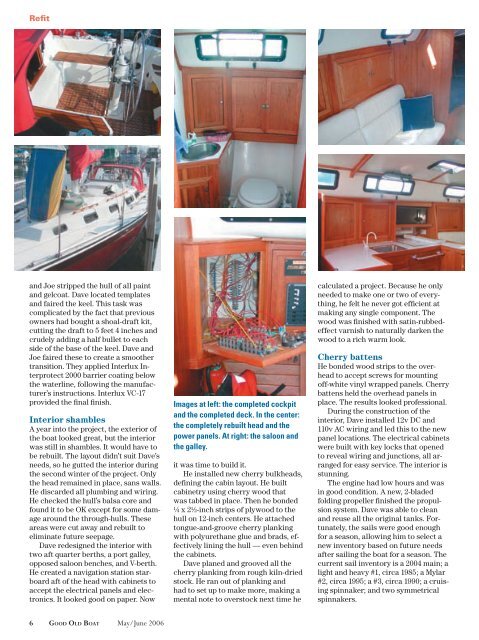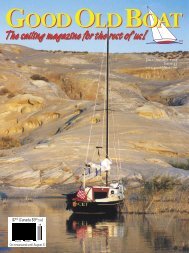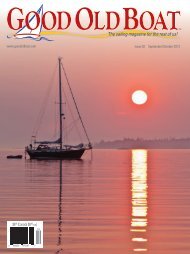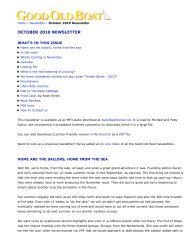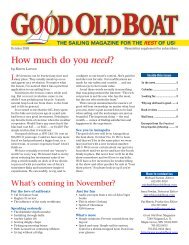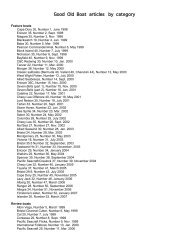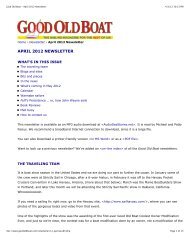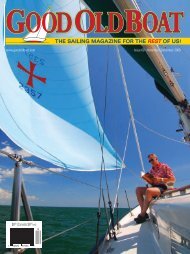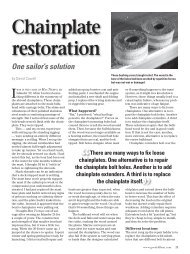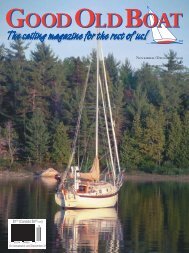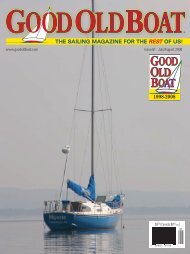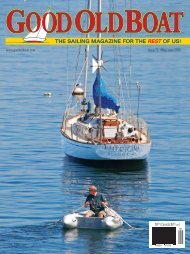The sailing magazine for the rest of us! - Good Old Boat Magazine
The sailing magazine for the rest of us! - Good Old Boat Magazine
The sailing magazine for the rest of us! - Good Old Boat Magazine
Create successful ePaper yourself
Turn your PDF publications into a flip-book with our unique Google optimized e-Paper software.
Refit<br />
and Joe stripped <strong>the</strong> hull <strong>of</strong> all paint<br />
and gelcoat. Dave located templates<br />
and faired <strong>the</strong> keel. This task was<br />
complicated by <strong>the</strong> fact that previo<strong>us</strong><br />
owners had bought a shoal-draft kit,<br />
cutting <strong>the</strong> draft to 5 feet 4 inches and<br />
crudely adding a half bullet to each<br />
side <strong>of</strong> <strong>the</strong> base <strong>of</strong> <strong>the</strong> keel. Dave and<br />
Joe faired <strong>the</strong>se to create a smoo<strong>the</strong>r<br />
transition. <strong>The</strong>y applied Interlux Interprotect<br />
2000 barrier coating below<br />
<strong>the</strong> waterline, following <strong>the</strong> manufacturer’s<br />
instructions. Interlux VC-17<br />
provided <strong>the</strong> final finish.<br />
Interior shambles<br />
A year into <strong>the</strong> project, <strong>the</strong> exterior <strong>of</strong><br />
<strong>the</strong> boat looked great, but <strong>the</strong> interior<br />
was still in shambles. It would have to<br />
be rebuilt. <strong>The</strong> layout didn’t suit Dave’s<br />
needs, so he gutted <strong>the</strong> interior during<br />
<strong>the</strong> second winter <strong>of</strong> <strong>the</strong> project. Only<br />
<strong>the</strong> head remained in place, sans walls.<br />
He discarded all plumbing and wiring.<br />
He checked <strong>the</strong> hull’s balsa core and<br />
found it to be OK except <strong>for</strong> some damage<br />
around <strong>the</strong> through-hulls. <strong>The</strong>se<br />
areas were cut away and rebuilt to<br />
eliminate future seepage.<br />
Dave redesigned <strong>the</strong> interior with<br />
two aft quarter berths, a port galley,<br />
opposed saloon benches, and V-berth.<br />
He created a navigation station starboard<br />
aft <strong>of</strong> <strong>the</strong> head with cabinets to<br />
accept <strong>the</strong> electrical panels and electronics.<br />
It looked good on paper. Now<br />
Images at left: <strong>the</strong> completed cockpit<br />
and <strong>the</strong> completed deck. In <strong>the</strong> center:<br />
<strong>the</strong> completely rebuilt head and <strong>the</strong><br />
power panels. At right: <strong>the</strong> saloon and<br />
<strong>the</strong> galley.<br />
it was time to build it.<br />
He installed new cherry bulkheads,<br />
defining <strong>the</strong> cabin layout. He built<br />
cabinetry <strong>us</strong>ing cherry wood that<br />
was tabbed in place. <strong>The</strong>n he bonded<br />
¼ x 2½-inch strips <strong>of</strong> plywood to <strong>the</strong><br />
hull on 12-inch centers. He attached<br />
tongue-and-groove cherry planking<br />
with polyurethane glue and brads, effectively<br />
lining <strong>the</strong> hull — even behind<br />
<strong>the</strong> cabinets.<br />
Dave planed and grooved all <strong>the</strong><br />
cherry planking from rough kiln-dried<br />
stock. He ran out <strong>of</strong> planking and<br />
had to set up to make more, making a<br />
mental note to overstock next time he<br />
calculated a project. Beca<strong>us</strong>e he only<br />
needed to make one or two <strong>of</strong> everything,<br />
he felt he never got efficient at<br />
making any single component. <strong>The</strong><br />
wood was finished with satin-rubbedeffect<br />
varnish to naturally darken <strong>the</strong><br />
wood to a rich warm look.<br />
Cherry battens<br />
He bonded wood strips to <strong>the</strong> overhead<br />
to accept screws <strong>for</strong> mounting<br />
<strong>of</strong>f-white vinyl wrapped panels. Cherry<br />
battens held <strong>the</strong> overhead panels in<br />
place. <strong>The</strong> results looked pr<strong>of</strong>essional.<br />
During <strong>the</strong> construction <strong>of</strong> <strong>the</strong><br />
interior, Dave installed 12v DC and<br />
110v AC wiring and led this to <strong>the</strong> new<br />
panel locations. <strong>The</strong> electrical cabinets<br />
were built with key locks that opened<br />
to reveal wiring and junctions, all arranged<br />
<strong>for</strong> easy service. <strong>The</strong> interior is<br />
stunning.<br />
<strong>The</strong> engine had low hours and was<br />
in good condition. A new, 2-bladed<br />
folding propeller finished <strong>the</strong> propulsion<br />
system. Dave was able to clean<br />
and re<strong>us</strong>e all <strong>the</strong> original tanks. Fortunately,<br />
<strong>the</strong> sails were good enough<br />
<strong>for</strong> a season, allowing him to select a<br />
new inventory based on future needs<br />
after <strong>sailing</strong> <strong>the</strong> boat <strong>for</strong> a season. <strong>The</strong><br />
current sail inventory is a 2004 main; a<br />
light and heavy #1, circa 1985; a Mylar<br />
#2, circa 1995; a #3, circa 1990; a cruising<br />
spinnaker; and two symmetrical<br />
spinnakers.<br />
6 GOOD OLD BOAT May/June 2006


